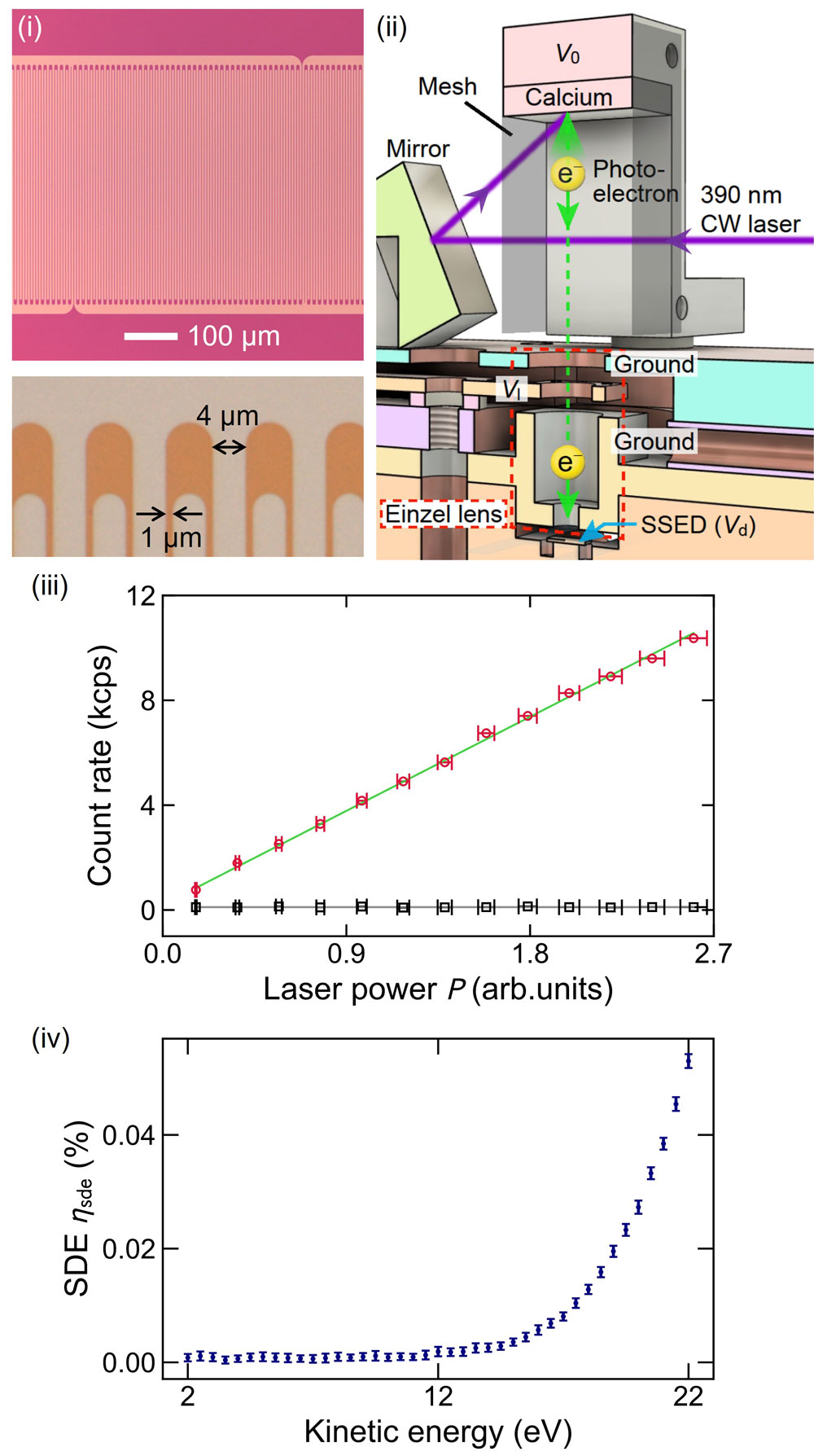ED4-3
Low-energy single-electron detection using a large-area superconducting micro-strip
Nov. 30 10:50-11:05
*Masato Shigefuji1, Alto Osada1,2, Masahiro Yabuno3, Shigehito Miki3,4, Hirotaka Terai3, Atsushi Noguchi1,5,6
Komaba Institute for Science (KIS), The University of Tokyo, Japan1
PPRESTO, Japan Science and Technology Agency, Japan2
Advanced ICT Research Institute, National Institute of Information and Communications Technology (NICT), Japan3
Graduate School of Engineering, Kobe University, Japan4
RIKEN Center for Quantum Computing (RQC), RIKEN, Japan5
Inamori Research Institute for Science (InaRIS), Japan6
Superconducting nano-strip single-photon detectors (SSPDs) [1] are excellent tools not only for photon detection but also for particle detection [2] owing to their high detection efficiency, low dark counts, and low time jitter. The detection mechanism relies on the heating of the electron subsystem in a superconductor by incident photons or particles. Interestingly, the former interact with electrons and excite quasiparticles directly, while the latter mainly excite phonons which heat electrons through the electron-phonon interaction. This difference results in a large difference in the minimum detectable energy: less than 1 eV for photons, on the other hand, ∼600 eV for ions [3], both using a ~1 μm-wide stripline. From this point of view, the minimum detectable energy for electrons is interesting because electrons can interact with both electrons and phonons in a superconductor. However, the detection of low-energy electrons with a superconducting stripline has not been explored yet [4]. In this presentation, we show the detection property of superconducting micro-strip single-electron detectors (SSEDs) for electrons with energy under 152 eV.
As shown in Fig. (i), the SSED we use has a large detection area to increase the prospective angle from an electron source. We make use of the photoelectric effect as a low-energy electron source, and the photoelectrons are focused on the SSED using an einzel lens [Fig. (ii)]. The number of emitted electrons is estimated from the photocurrent, which is used to calculate the system detection efficiency (SDE).
We measure the dependence of the count rate of the SSED on the laser power and the result is shown in Fig. (iii). The count rate increases linearly with the laser power and depends on the applied voltages, indicating that photoelectrons are detected with our SSED. Then, as shown in Fig. (iv), we measure the SDE as a function of the kinetic energy of incident electrons. The result shows that in our experimental set-up, the minimum detectable energy for electrons is 15 eV, which is much lower than that of ions. This implies that electrons can transfer energy to the electron subsystem in a superconductor than ions by the electron-electron interaction. Our results show that SSEDs might open a wide range of applications ranging from condensed matter physics (e.g., quantum electron microscopy and cryogenic low-energy electron diffraction) to quantum information science (e.g., electrons in a Paul trap).
Captions for Figures
(i) (top) Optical micrograph of the SSED with a large active area of 420×420 μm² with a filling factor of 20 %. The NbTiN film is shown in pink. (bottom) Enlarged view. The superconducting strip-line (orange) is 1 μm wide and 4 μm pitch.
(ii) Schematic cross-sectional view of the experimental set-up in a helium-3 refrigerator. The 390 nm-wavelength CW laser passes through the optical windows of the refrigerator and holes of two stainless steel meshes (not shown) and then is reflected by the mirror towards the calcium slab. Electrons are emitted by the photoelectric effect and accelerated towards the SSED. The initial potential energy of electrons is controlled by a voltage V0. The electrons are focused on the SSED without changing the kinetic energy using an einzel lens with a voltage Vl (enclosed by the red dotted line).
(iii) Count rates for V0 = −100 V, Vl = 18 V (red circles) and V0 = Vl = 0 V (black squares) as a function of a 390 nm laser power P. A bias current of Ib/Ic,exp ≈ 0.98 and a bias voltage of Vd = 2 V are applied to the SSED , where Ic,exp is the experimental critical current. The error bars correspond to one standard deviation which originates principally in the fluctuation of the laser power.
(iv) SDE ηsde as a function of electron energy Ek for Vl = 18 V. The error bars represent one standard deviation. A bias current of Ib/Ic,exp ≈ 0.98 and a bias voltage of Vd = 2 V are applied.
References
[1] G. Gol’tsman, O. Okunev, G. Chulkova, A. Lipatov, A. Semenov, K. Smirnov, B. Voronov, A. Dzardanov, C. Williams, and R. Sobolewski, “Picosecond superconducting single-photon optical detector,” Applied physics letters 79, 705–707 (2001).
[2] R. Cristiano, M. Ejrnaes, A. Casaburi, N. Zen, and M. Ohkubo, “Superconducting nano-strip particle detectors,” Superconductor Science and Technology 28, 124004 (2015).
[3] M. Sclafani, M. Marksteiner, F. M. Keir, A. Divochiy, A. Korneev, A. Semenov, G. Gol’tsman, and M. Arndt, “Sensitivity of a superconducting nanowire detector for single ions at low energy,” Nanotechnology 23, 065501 (2012).
[4] M. Rosticher, F. Ladan, J. Maneval, S. Dorenbos, T. Zijlstra, T. Klapwijk, V. Zwiller, A. Lupaşcu, and G. Nogues, “A high efficiency superconducting nanowire single electron detector,” Applied Physics Letters 97, 183106 (2010).
